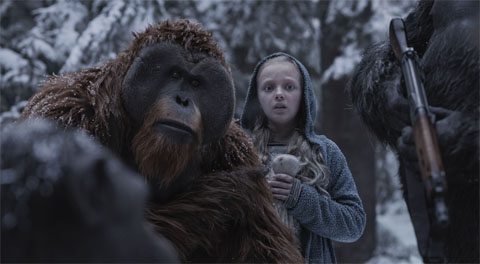
Image courtesy of Chernin Entertainment/20th Century Fox
War for the Planet of
the Apes
| published July 18, 2017 |
By Cameron Dale,
Thursday Review contributor
The Planet of the Apes franchise has been around since before I was born, or even thought of by my parents. The first movie dates to when my dad was a teenager. It’s easy for moviegoers to forget that the current Apes franchise dates back only about six years, to the start of the reboot with 2011’s Rise of the Planet of the Apes. It was a remake, plain and simple, using infinitely better special effects and top-drawer digital technologies, but not necessarily better sci-fi tale-telling.
The original 1968 version—starring Charlton Heston, Roddy McDowall, Kim Hunter and James Whitmore—is a classic of sci-fi cinema, a movie with a hook ending so mind-blowing that it made the heads of some audience members explode at the time (at least that what I read somewhere). Nearly fifty years later, it still packs a wallop, especially among those who enjoy the paradoxes and paradigms of time travel and the potential power to destroy the Earth with nuclear weapons.
Directed by Franklin Schaffner (he won Oscars for both Patton and Papillon), based on the classic novel by Pierre Boulle, and scripted by Rod Serling and Michael Wilson, Planet of the Apes (1968) spawned its own prodigious series of sequels, a movie juggernaut which stretched from the late 1960s well into the 1970s before petering out—but not before it sought to go full circle, as it were, by connecting audiences to the core (but previously unstated) premise of the first.
Intended at the time to be the start of a new franchise reboot, the movie did reasonably well at the box office, but failed to spark much enthusiasm for a reprisal of the characters as written in that grand version.
War is a direct sequel to Rise of the Planet of the Apes (2011). Starring Andy Serkis as Ceasar, Woody Harrelson as “The Colonel,” Steve Zahn as “Bad Ape,” Judy Greer as "Cornelia," and Amiah Miller as "Nova." Director Matt Reeves returns for his third stint as director of a series first rebooted by Tim Burton, and Reeves also gets credits for writing and scripting on this installment.
The plot unfolds roughly like this: In the distant future, the militaries of the U.S. and other major powers are engaged in a prolonged, multi-front war with armed and dangerous apes now living and operating deep in the forests of Earth. And in spite of attempts to negotiate peace, a powerful but rogue colonel (Harrelson) has formed his own elite army known as the Alpha-Omega force. Alpha-Omega’s mission is uncomplicated: track the primates, relentlessly engage the ape armies and exterminate them, using any and all tactics at their disposal. But when several of those human soldiers are captured, the apes learn that humans are in the early stages of de-evolution—regressing in both communication skills and reasoning ability. Some of the human survivors have become mute, others unable to comprehend anything but the role as carriers of weapons.
In addition, there are the usual and predictable rivalries within the complex world of the apes, with some willing to follow Caesar, others demanding more violent outcomes, still others ready to sue for peace. These factional struggles put stress on an already dangerous and unpredictable powder-keg in a world in which mutations are steadily reversing the role of both humans and non-human primates. The title takes seriously its place in the sequence of events as told in this version: war seems the common thread, triggered by revenge, retribution, old grievances and shifting evolutionary pressures. Both sides misunderstand the other—the humans deeply untrusting of the apes, the apes and their leaders suspicious of the human war-machine.
War for Planet of the Apes also evokes frequent visual and stylistic numerous references to movies about conflict and armed violence; some scenes seem to pay homage to Vietnam-era cinematic depictions, including Platoon, Full Metal Jacket, and Apocalypse Now. Even Harrelson’s character (a colonel, no less) harkens overtly and purposefully back to the images of Marlon Brando as Colonel Kurtz from Francis Ford Coppola’s masterpiece. Other scenes—relying heavily on the digital technologies which make such grand spectacles possible—evoke sweeping the battles scenes of Troy, War Horse, or Saving Private Ryan.
The cinematography is lush, transcendent, and blanketed with nature’s backdrop, reminding viewers at every turn that there is a natural order and divine architecture to the world even as two species fight relentlessly for primacy. In that sense, the movie also harkens to the mystical and spiritual themes which run as an undercurrent through Thin Red Line, the moody and evocative Pacific theater World War II film directed by Terrence Malick and based on the book by author James Jones.
Add to that a well-crafted musical score, which underplays its hand rather than overpowering us, which lends the film a more classically crafted tone than what you might expect from anything yet attempted over the decades of Apes moviemaking.
So, despite going in to the theater with the expectation of something campy and corny, I was impressed with the film’s loyalty to not only the ethos of great science-fiction, but also the movie’s earnest desire to be taken seriously, without sacrificing entertainment value. In a summer of big-budget blockbusters (Spiderman; Transformers; Wonder Woman; The Mummy, to name but four), Apes was a pleasant surprise. See it soon, while it remains on the large screens.
Related Thursday Review articles:
Kong: Skull Island; Cameron Dale; Thursday Review; March 14, 2017.
Alien Covenant Delivers the Goods, and the Bads; Cameron Dale; Thursday Review; June 2, 2017.
